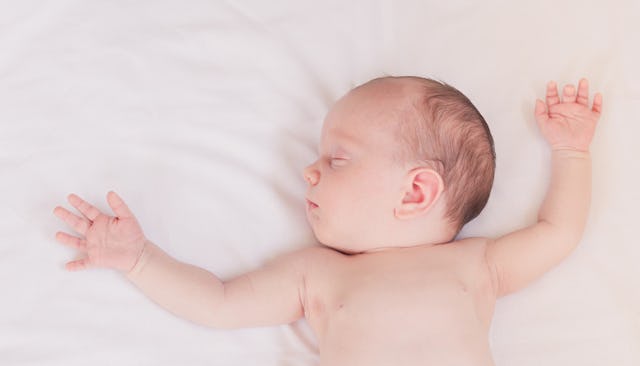SIDS Risk Involves Way More Than Baby's Sleep Environment

The American Academy of Pediatrics (AAP) has long acknowledged the safety benefits of having babies sleep on their backs with minimal soft bedding near them. While it’s still crucial for parents to follow the AAP’s recommendations on sleep position and crib bedding, new research is showing that the major elements contributing to a baby dying of SIDS have little to do with sleep environment. They include a mother smoking and drinking during pregnancy, genetic factors, breastfeeding rates and the age of the baby. Sleep environment is a factor, but it’s far from the only thing to consider.
A new study authored by Dr. Richard Goldstein, of Dana-Farber/Boston Children’s Cancer and Blood Disorders Center, theorizes that there are three main elements that cause SIDS. The first is that some babies may have an “intrinsic predisposition” to SIDS, thought to involve “genetic, developmental and environmental factors.” These include things such as whether a mother smoked or drank during pregnancy, which is shown to increase the risk for SIDS, and if a baby is a boy or born prematurely. Both are known factors that make an infant more prone to SIDS-related deaths. Breastfeeding is also grouped in with these factors, as studies have shown it reduces risk of SIDS.
The second element is the baby’s age, with children under six months old being at the greatest risk. The third is sleeping environment, including sleep position and the type of crib bedding. When researchers analyzed the rates of SIDS between 1983 and 2012, it was discovered that between 1992 and 1996, “a sharp, 38-percent decrease in SIDS occurred in the United States.” This was around the time the AAP began recommending putting babies to sleep on their backs rather than chest-down.
Although the sleep environment recommendations were a factor in the 1990’s decrease in SIDS deaths, it’s also significant that rates of smoking during pregnancy decreased and breastfeeding rates increased. The study concludes saying “If we are to further impact infant mortality rates and eliminate SIDS, focus on the sleep environment will continue to be important, but will likely be insufficient.” As Dr. Goldstein says, “These days, most infants diagnosed with SIDS are not found sleeping prone [on the belly].” This points to other factors being more significant than sleep position.
Overall, the study backs up what parents have long been told — that having infants sleep on their backs is safest and that cribs should be kept free of soft bedding including blankets near a baby’s face and crib bumpers. All of that matters in reducing SIDS risk overall. However, Dr. Rachel Moon and Dr. Fern Hauck, both at the University of Virginia in Charlottesville, wrote in an editorial published in the same journal as Goldstein’s study that factors besides sleep environment are still a crucial focus. “Public health efforts will need to also focus on decreasing intrinsic risk through the promotion of smoking cessation, elimination of in utero drug and alcohol exposure, and increasing rates of breast-feeding and access to high-quality prenatal care.”
As parents, all we ever want is to keep our children safe and healthy. There is so much information out there on every topic under the sun, some of it conflicting, but knowledge is always power. The more we know and the more credible the sources, the better equipped we are to care for our babies. Studies like this often prove to be polarizing, with some people believing them to be true with others defending their way of doing things. It’s important to keep current with the information from these studies, as it’s always changing, and to take the pieces of information we find useful and continue to research in order to make the best decisions for our families.
This article was originally published on